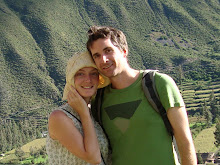


After three days of trekking, which would be fairly easy in the dry season but felt like a real achievement in the rain, we reached the steps to the lost city of the Tayrona. Over 1200 steps that is, which I think is only like walking to the top of the Eiffel tower but with the added challenge of the steps being all different shapes and sizes and rather slippery.
We climbed the steps to find a series or terraces and stone paths winding through the lush jungle. There are 217 restored stone terraces to explore with maybe another 2000 hidden in trees and an estimated 5000 in the surrounding area. Sadly all the riches of the lost city were long gone, mostly plundered while the whereabouts of the city was still a secret, but it was still an amazing thought that much of the central ‘sacred’ area would have been dripping with gold and precious offerings. And that the place would have been alive with little long-haired (hair was sacred and was only cut as a punishment if you were really very naughty just before you were left in a pit - see below - for a few months to be punished by Mother Earth- sun, water, mosquitoes etc) pre-Hispanic people (av. Height 1.2m) at the centre of an extensive community stretching across the mountains and to the coast.
What are now partially restored ruins were once home to a sophisticated population of about 3000 people. All of the terraces are round because they worshiped the sun (and Mother Earth) and all the houses were round and had twin peaks on the straw roofs to represent the two highest peaks in the mountains.
The Sacred zone was where people came with offerings to give them strength or good fortune in their lives; when they needed a good crop of food or were off to war with some other tribe. There were also zones for housing guests who wanted to make offerings and for melting stone with secret magic liquid. We were naturally curious and a little suspicious as to just how our guides knew such information but apparently it was very well documented by the conquistadors before they destroyed the community during nearly 100 years of war and finally by making everyone ill with flu and yellow fever until the last few fled. Before too much sympathy is given, it should be pointed out that the little folk achieved their unchallenged empire by wiping out all other local tribes in some pretty violent wars.
We enjoyed our wander round the city that was lost for 600 years and Rachel did a splendid job translating all the information from Spanish for our English speaking ensemble of Irish, an Italian and an American. Most of all it was just a privilege to be spending time in such an amazing environment where it was easy to see why the Tayrona led their lives according to the Mother Earth they worshipped.






No comments:
Post a Comment